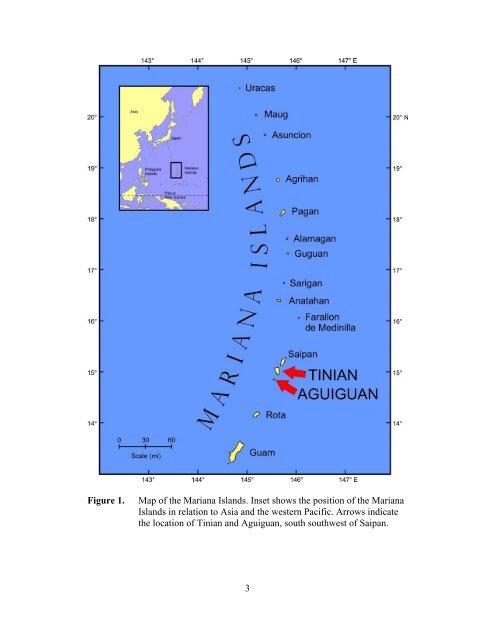18.01.2015
•
Views
MATERIALS AND METHODS Tinian, the third-largest islong>andong> in the Mariana Islong>andong>s, is located between latitude 14E55' N ong>andong> 15E06' N ong>andong> longitude 145E35' E ong>andong> 145E40' E, some 8 km south southwest ong>ofong> Saipan ong>andong> 128 km north ong>ofong> Guam (Figure 1). The islong>andong> is about 20 km long on its north-south axis ong>andong> 10 km wide on its east-west axis, with a long>andong> area ong>ofong> about 102 km 2 . Basement Eocene volcanic rocks are overlain by Miocene ong>andong> Plio-Pleistocene coral ong>andong> algal limestone ong>andong> Holocene raised beach ong>andong> reef deposits. Doan et al. (1960) mapped ong>andong> described five physiographic divisions ong>ofong> the islong>andong>: 1) a high, southern ridge, where the islong>andong>’s highest elevation (187 m) is located; 2) a low, median valley that bisects the islong>andong> in a northeastsouthwest direction; 3) a large central plateau; 4) a small, north-central highlong>andong> with a maximum elevation ong>ofong> 166 m; ong>andong> 5) a northern lowlong>andong> (Figure 2). Aguiguan is a small, steep-sided islong>andong> ong>ofong> approximately 7.2 km 2 located 8 km southwest ong>ofong> Tinian at 14E51' N ong>andong>145E33' E. The islong>andong> is composed entirely ong>ofong> limestone ong>andong> rises to an elevation ong>ofong> 157 m. Most ong>ofong> the coastline consists ong>ofong> sheer limestone cliffs rising abruptly from the sea in a series ong>ofong> eight separate terraces (Tayama ong>andong> Ota, 1940). The terraces have been variously grouped into three (Butler, 1992) or four (Tayama ong>andong> Ota, 1940) major terraces. The uppermost terrace forms a nearly flat, central plateau. There are no beaches or embayments (Figure 3). Terrestrial gastropod populations were surveyed by two methods. For arboreal species, a modification ong>ofong> the method used by Hopper ong>andong> Smith (1992) was used. Thirty-minute visual surveys were conducted by observers in forested areas ong>ofong> the islong>andong>s. Locations ong>ofong> sampling sites were determined by GPS (Garmin ® GPS 72). Presence or absence ong>ofong> ong>snailsong> was determined by examining leaves ong>ofong> broad-leaved tree species, including Hernong>andong>ia sonora, Guamia mariannae, Cynometra ramiflora, Neisosperma oppositifolia, Ochrosia mariannensis, Mammea odorata, ong>andong> Aglaia mariannensis, which serve as host species for partulids in other Mariana Islong>andong>s. Special emphasis was given to re-visiting sites in Aguiguan where Partula langfordi, an Aguiguan endemic, ong>andong> Partula gibba were reported historically (Craig ong>andong> Chong>andong>ran, 1992; Smith, 1995; Kondo, unpublished data). These species were listed as Cong>andong>idate Species for protection under the U.S. Endangered Species Act. No published records ong>ofong> partulid tree snail distribution in Tinian are known; Kondo (1970) reported Partula gibba from Tinian, but he did not provide locality data. When live arboreal ong>snailsong> were located within the visual census period, 25-m 2 plots were established under the densest understory, as determined by a spherical densiometer. During a 30-min search, all ong>snailsong> located to 2 m height within the plots were identified to species or collected ong>andong> preserved in 75.5% ethanol for identification in the laboratory. Shell lengths ong>ofong> specimens were measured to the nearest 0.1 mm with sliding vernier calipers (Digimatic ® 500- 136, Mitutoyo Corp.) or with a Peak ® 10x Scale Loupe. Host tree species were recorded for each snail observed. Leaf litter was examined for 10 min in search ong>ofong> fresh partulid ground shells at each sampling site. Observations ong>ofong> dead ground shells were recorded. If no live ong>snailsong> or fresh 2
Figure 1. Map ong>ofong> the Mariana Islong>andong>s. Inset shows the position ong>ofong> the Mariana Islong>andong>s in relation to Asia ong>andong> the western Pacific. Arrows indicate the location ong>ofong> Tinian ong>andong> Aguiguan, south southwest ong>ofong> Saipan. 3



